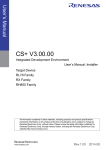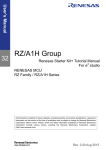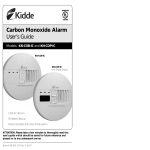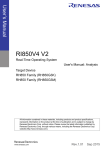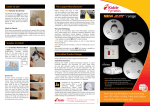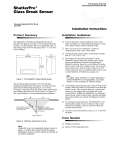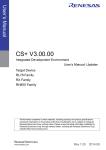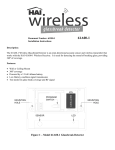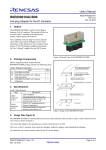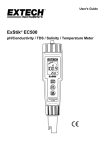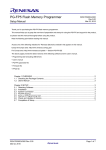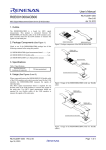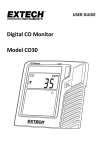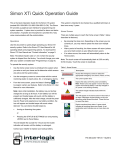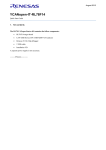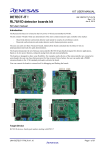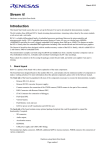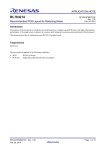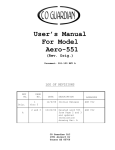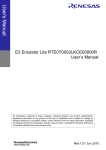Download Quick start guide
Transcript
QUICK START GUIDE DETECT-IT! RL78/I1D detector boards kit QSG-YDETECT-IT-RL78 Rev.1.30 24 Feb, 2015 Quick Start Guide 1. Introduction This quick start guide assists the user to connect and use rapidly the detector solution kit Detect it!. The detector demonstrators consists of different boards: glass break detector demonstrator, monoxide carbon detector demonstrator, motion detector demonstrator, smoke detector demonstrator. All the boards contain into the Detect it! kit are preprogrammed and ready for quick demonstration. Please check the content of the kit using the content list written on the box, and notify your supplier if any part is missing. Update about the content of the kit can be find on the Detect it!kit dedicated web page : www.renesas.eu/detector/ 2. Boards layout You will find below picture of each board with short explanation of the main parts. For more details, please refer to the Detect it! user manual. The name of each board is written, on the PCB. Please look at the PCB to identify each board. 2.1 Glass Break detector board layout Please check the name of the board you are looking “GLASSBREAK_SENSOR_I1D” QSG-YDETECT-IT-RL78 V1.30 Page 1 of 10 DETECT-IT RL78/I1D detector boards kit Quick Start Guide Figure Glass break detector top view 2.2 CO detector board layout Please check the name of the board you are looking “CO_SENSOR_I1D” Figure CO detector top view 2.3 Motion detector board layout Please check the name of the board you are looking “MOTION_SENSOR_I1D” QSG-YDETECT-IT-RL78 V1.30 Page 2 of 10 DETECT-IT RL78/I1D detector boards kit Quick Start Guide Figure Motion detector top view 2.4 Smoke detector board layout Please check the name of the board you are looking “SMOKE_SENSOR_I1D” QSG-YDETECT-IT-RL78 V1.30 Page 3 of 10 DETECT-IT RL78/I1D detector boards kit Quick Start Guide Figure Smoke detector top view 3. Initial board configuration 3.1 Glass Break detector board In order to start the demonstration of the Glass Break detector, please ensure that this initial configuration is done: • J1 should be closed • J2 should be closed • J3 should be closed 3.2 CO detector board In order to start the demonstration of the CO detector, please ensure that this initial configuration is done: • • • • J1 should be closed J2 should be closed DN_J10 should be open DN_J14 can be closed or opened 3.3 Motion detector board In order to start the demonstration of the Motion detector, please ensure that this initial configuration is done: QSG-YDETECT-IT-RL78 V1.30 Page 4 of 10 DETECT-IT RL78/I1D detector boards kit • • • • Quick Start Guide J1 should be closed J2 should be closed J3 should be closed J8 should be opened 3.4 Smoke detector board In order to start the demonstration of the Smoke detector, please ensure that this initial configuration is done: • J1 should be closed • J2 should be closed • J3 should be open • J6 should be closed • J7 (pins 1-2) should be closed • Please check that IR photodiode and IR LED are in place 4. Starting up boards and quick tests Please make sure you are equipped with a 3V Lithium battery CR123. Only one CR123 battery is provided with each kit. Once the jumpers of each board are set, please follow the below steps. 4.1 Glass Break detector demonstration using battery Step 1 / Insert the CR123 battery into the battery location of the Glass Break detector (this is on the reverse side of the board), please be careful about the polarity. Step 2 / Press the reset button. Step 3 / Try different noise: To test for false Glass break event detection, a loud hand clap can be tried at a distance of 0.5 meter or greater distance from the Glass break microphone. If a loud hand clap is made less even closer or so distance, it is easier to induce a false detection event. To test for true Glass break event detector, a specific test system can be used as a glass break sound simulator like Interlogix Model 5709C Shatter Series Tester. This glass break simulator has 3 different selectable sound simulations: (1) Plate glass, (2) Tempered glass, and (3) Laminated glass. Each of these glass break simulations has a different duration and frequency content. To use this unit, hold the Model 5709C output speaker in the direction of the Glass break sensor microphone within short distance. The alarm will sound if high frequency Glass break sound is detected. An easier method is to play some sound track emulating the typical glass break noise. Step 4 / Stop the alarm by pressing the reset button. Step 5 / Power off the detector by removing the battery. For more information about the Glass Break detector operation, please refer to the user manual of the kit. The Glass Break detector demonstrator can be also demonstrated using the E1 debugger as power supply. For more information, please refer to the user manual of the detector kit provided into the CD-ROM. 4.2 CO detector demonstration using battery Step 1 / Insert the CR123 battery into the battery location of the CO detector (this is on the reverse side of the board), please be careful about the polarity. Step 2 / Press the reset button. Step 3 / The CO detector is impossible to test without specific equipment. To test the CO sensor for gas concentration accuracy, a product available in the market was used. The Kidde Carbon Monoxide Alarm, Model KN-COPP-B-LPM, which has an LCD readout capable of showing CO gas concentration levels of 0-999ppm was the model used. For measurement setup, a Zip-Loc TM style bag was used to contain the CO sensor board from Renesas, the Kidde CO alarm measuring unit and CO gas itself. QSG-YDETECT-IT-RL78 V1.30 Page 5 of 10 DETECT-IT RL78/I1D detector boards kit Quick Start Guide This way it is also possible to measure the DC output of trans-conductance amplifier output AMP0O and verify that the alarm threshold is triggered at appropriate level. Step 4 / Stop the alarm by pressing the reset button. Step 5 / Power off the detector by removing the battery. For more information about the CO detector operation, please refer to the user manual of the kit. The CO detector demonstrator can be also demonstrated using the E1 debugger as power supply. For more information, please refer to the user manual of the detector kit provided into the CD-ROM. 4.3 Motion detector demonstration using battery Step 1 / Insert the CR123 battery into the battery location of the Motion detector (this is on the reverse side of the board), please be careful about the polarity. Step 2 / Press the reset button. Step 3 / The motion detector is easy to test. The sensor board will detect a motion of a human from distance of 4m. The sensor board can be fine-tuned with the potentiometers (Please refer to user manual and schematics for more information). Once the motion is detected, an alarm will sound. Step 4 / Stop the alarm by pressing the reset button. Step 5 / Power off the detector by removing the battery. For more information about the Motion detector operation, please refer to the user manual of the kit. The Motion detector demonstrator can be also demonstrated using the E1 debugger as power supply. For more information, please refer to the user manual of the detector kit provided into the CD-ROM. 4.4 Smoke detector demonstration using battery Step 1 / Insert the CR123 battery into the battery location of the Smoke detector (this is on the reverse side of the board), please be careful about the polarity. Step 2 / Press the reset button. Step 3 / If you have some “Smoke Check” and “Smoke-In-a-Can” brand spray cans available, then the Smoke sensor works well with “Smoke Check” and “Smoke-In-a-Can” brand spray cans. After about 0.5 to 1 second of Smoke spray the alarm acts within 3 seconds and turns on alarm for multiple cycles of 6 seconds ON and 3 seconds OFF. If you do not have such type of spray cans, then it is possible to put an obstacle in the infrared beam, to replace the “smoke” spray. After about 0.5 to 1 second of the presence of the obstacle, the alarm acts within 3 seconds and turns on alarm for multiple cycles of 6 seconds ON and 3 seconds OFF. Step 4 / Stop the alarm by pressing the reset button. Step 5 / Power off the detector by removing the battery. For more information about the Smoke detector operation, please refer to the user manual of the kit. The Smoke detector demonstrator can be also demonstrated using the E1 debugger as power supply. For more information, please refer to the user manual of the detector kit provided into the CD-ROM. 5. Next Step After you have completed this quick start procedure, please review documentation that came with the kit, especially the resources available on the CD-ROM. The CD-ROM contains more information about the detector kits, please refer to it in case of any problems or for more information about the kit. Please find the content of the kit here : Table CD ROM content list QSG-YDETECT-IT-RL78 V1.30 Page 6 of 10 DETECT-IT RL78/I1D detector boards kit CD ROM folder Samples Programs Documentation Acroread Application Leading Tool Renesas Flash Programmer Videos 6. Quick Start Guide Description of resources IAR Samples programs for each demonstrators boards • IAR samples program for Glass Break demonstrator • IAR samples program for CO demonstrator • IAR samples program for Motion demonstrator • IAR samples program for Smoke demonstrator • User manual of the Detect it! kit • User manual of the microcontroller RL78/I1D • Quick start guide of the Detect it! Kit • Datasheets of the various sensors and crystals used. For each demonstrator boards : • Schematics • Gerber files • Bill of Material PDF reader Latest version of Code generator tool provided by Renesas for RL78 series including RL78/I1D Latest version of Flash Programmer tool provided by Renesas for all MCU • Detect it! Kit Promotion video • Detect it! Kit Technical video Support In case of issues to operate the board, please check if there is any update available on Renesas website : www.renesas.eu/detector/ Or contact your local office. www.renesas.com All trademarks and registered trademarks are the property of their respective owners. QSG-YDETECT-IT-RL78 V1.30 Page 7 of 10 Revision History Rev. 1.00 1.10 1.30 Date 15/09/2014 08/01/2015 24/02/2015 Description Page 9 10 10 Summary First version of quick start guide Small corrections for first release Small corrections for improvements A-1 General Precautions in the Handling of MPU/MCU Products The following usage notes are applicable to all MPU/MCU products from Renesas. For detailed usage notes on the products covered by this document, refer to the relevant sections of the document as well as any technical updates that have been issued for the products. 1. Handling of Unused Pins Handle unused pins in accordance with the directions given under Handling of Unused Pins in the manual. The input pins of CMOS products are generally in the high-impedance state. In operation with an unused pin in the open-circuit state, extra electromagnetic noise is induced in the vicinity of LSI, an associated shoot-through current flows internally, and malfunctions occur due to the false recognition of the pin state as an input signal become possible. Unused pins should be handled as described under Handling of Unused Pins in the manual. 2. Processing at Power-on The state of the product is undefined at the moment when power is supplied. The states of internal circuits in the LSI are indeterminate and the states of register settings and pins are undefined at the moment when power is supplied. In a finished product where the reset signal is applied to the external reset pin, the states of pins are not guaranteed from the moment when power is supplied until the reset process is completed. In a similar way, the states of pins in a product that is reset by an on-chip power-on reset function are not guaranteed from the moment when power is supplied until the power reaches the level at which resetting has been specified. 3. Prohibition of Access to Reserved Addresses Access to reserved addresses is prohibited. The reserved addresses are provided for the possible future expansion of functions. Do not access these addresses; the correct operation of LSI is not guaranteed if they are accessed. 4. Clock Signals After applying a reset, only release the reset line after the operating clock signal has become stable. When switching the clock signal during program execution, wait until the target clock signal has stabilized. When the clock signal is generated with an external resonator (or from an external oscillator) during a reset, ensure that the reset line is only released after full stabilization of the clock signal. Moreover, when switching to a clock signal produced with an external resonator (or by an external oscillator) while program execution is in progress, wait until the target clock signal is stable. 5. Differences between Products Before changing from one product to another, i.e. to a product with a different part number, confirm that the change will not lead to problems. The characteristics of an MPU or MCU in the same group but having a different part number may differ in terms of the internal memory capacity, layout pattern, and other factors, which can affect the ranges of electrical characteristics, such as characteristic values, operating margins, immunity to noise, and amount of radiated noise. When changing to a product with a different part number, implement a system-evaluation test for the given product. Notice 1. Descriptions of circuits, software and other related information in this document are provided only to illustrate the operation of semiconductor products and application examples. You are fully responsible for the incorporation of these circuits, software, and information in the design of your equipment. Renesas Electronics assumes no responsibility for any losses incurred by you or third parties arising from the use of these circuits, software, or information. 2. Renesas Electronics has used reasonable care in preparing the information included in this document, but Renesas Electronics does not warrant that such information is error free. Renesas Electronics assumes no liability whatsoever for any damages incurred by you resulting from errors in or omissions from the information included herein. 3. Renesas Electronics does not assume any liability for infringement of patents, copyrights, or other intellectual property rights of third parties by or arising from the use of Renesas Electronics products or technical information described in this document. No license, express, implied or otherwise, is granted hereby under any patents, copyrights or other intellectual property rights of Renesas Electronics or others. 4. You should not alter, modify, copy, or otherwise misappropriate any Renesas Electronics product, whether in whole or in part. Renesas Electronics assumes no responsibility for any losses incurred by you or 5. Renesas Electronics products are classified according to the following two quality grades: "Standard" and "High Quality". The recommended applications for each Renesas Electronics product depends on third parties arising from such alteration, modification, copy or otherwise misappropriation of Renesas Electronics product. the product's quality grade, as indicated below. "Standard": Computers; office equipment; communications equipment; test and measurement equipment; audio and visual equipment; home electronic appliances; machine tools; personal electronic equipment; and industrial robots etc. "High Quality": Transportation equipment (automobiles, trains, ships, etc.); traffic control systems; anti-disaster systems; anti-crime systems; and safety equipment etc. Renesas Electronics products are neither intended nor authorized for use in products or systems that may pose a direct threat to human life or bodily injury (artificial life support devices or systems, surgical implantations etc.), or may cause serious property damages (nuclear reactor control systems, military equipment etc.). You must check the quality grade of each Renesas Electronics product before using it in a particular application. You may not use any Renesas Electronics product for any application for which it is not intended. Renesas Electronics shall not be in any way liable for any damages or losses incurred by you or third parties arising from the use of any Renesas Electronics product for which the product is not intended by Renesas Electronics. 6. You should use the Renesas Electronics products described in this document within the range specified by Renesas Electronics, especially with respect to the maximum rating, operating supply voltage range, movement power voltage range, heat radiation characteristics, installation and other product characteristics. Renesas Electronics shall have no liability for malfunctions or damages arising out of the use of Renesas Electronics products beyond such specified ranges. 7. Although Renesas Electronics endeavors to improve the quality and reliability of its products, semiconductor products have specific characteristics such as the occurrence of failure at a certain rate and malfunctions under certain use conditions. Further, Renesas Electronics products are not subject to radiation resistance design. Please be sure to implement safety measures to guard them against the possibility of physical injury, and injury or damage caused by fire in the event of the failure of a Renesas Electronics product, such as safety design for hardware and software including but not limited to redundancy, fire control and malfunction prevention, appropriate treatment for aging degradation or any other appropriate measures. Because the evaluation of microcomputer software alone is very difficult, please evaluate the safety of the final products or systems manufactured by you. 8. Please contact a Renesas Electronics sales office for details as to environmental matters such as the environmental compatibility of each Renesas Electronics product. Please use Renesas Electronics products in compliance with all applicable laws and regulations that regulate the inclusion or use of controlled substances, including without limitation, the EU RoHS Directive. Renesas Electronics assumes no liability for damages or losses occurring as a result of your noncompliance with applicable laws and regulations. 9. Renesas Electronics products and technology may not be used for or incorporated into any products or systems whose manufacture, use, or sale is prohibited under any applicable domestic or foreign laws or regulations. You should not use Renesas Electronics products or technology described in this document for any purpose relating to military applications or use by the military, including but not limited to the development of weapons of mass destruction. When exporting the Renesas Electronics products or technology described in this document, you should comply with the applicable export control laws and regulations and follow the procedures required by such laws and regulations. 10. It is the responsibility of the buyer or distributor of Renesas Electronics products, who distributes, disposes of, or otherwise places the product with a third party, to notify such third party in advance of the contents and conditions set forth in this document, Renesas Electronics assumes no responsibility for any losses incurred by you or third parties as a result of unauthorized use of Renesas Electronics products. 11. This document may not be reproduced or duplicated in any form, in whole or in part, without prior written consent of Renesas Electronics. 12. Please contact a Renesas Electronics sales office if you have any questions regarding the information contained in this document or Renesas Electronics products, or if you have any other inquiries. (Note 1) "Renesas Electronics" as used in this document means Renesas Electronics Corporation and also includes its majority-owned subsidiaries. (Note 2) "Renesas Electronics product(s)" means any product developed or manufactured by or for Renesas Electronics. SALES OFFICES http://www.renesas.com Refer to "http://www.renesas.com/" for the latest and detailed information. Renesas Electronics America Inc. 2801 Scott Boulevard Santa Clara, CA 95050-2549, U.S.A. Tel: +1-408-588-6000, Fax: +1-408-588-6130 Renesas Electronics Canada Limited 1101 Nicholson Road, Newmarket, Ontario L3Y 9C3, Canada Tel: +1-905-898-5441, Fax: +1-905-898-3220 Renesas Electronics Europe Limited Dukes Meadow, Millboard Road, Bourne End, Buckinghamshire, SL8 5FH, U.K Tel: +44-1628-585-100, Fax: +44-1628-585-900 Renesas Electronics Europe GmbH Arcadiastrasse 10, 40472 Düsseldorf, Germany Tel: +49-211-6503-0, Fax: +49-211-6503-1327 Renesas Electronics (China) Co., Ltd. Room 1709, Quantum Plaza, No.27 ZhiChunLu Haidian District, Beijing 100191, P.R.China Tel: +86-10-8235-1155, Fax: +86-10-8235-7679 Renesas Electronics (Shanghai) Co., Ltd. Unit 301, Tower A, Central Towers, 555 Langao Road, Putuo District, Shanghai, P. R. China 200333 Tel: +86-21-2226-0888, Fax: +86-21-2226-0999 Renesas Electronics Hong Kong Limited Unit 1601-1613, 16/F., Tower 2, Grand Century Place, 193 Prince Edward Road West, Mongkok, Kowloon, Hong Kong Tel: +852-2265-6688, Fax: +852 2886-9022/9044 Renesas Electronics Taiwan Co., Ltd. 13F, No. 363, Fu Shing North Road, Taipei 10543, Taiwan Tel: +886-2-8175-9600, Fax: +886 2-8175-9670 Renesas Electronics Singapore Pte. Ltd. 80 Bendemeer Road, Unit #06-02 Hyflux Innovation Centre, Singapore 339949 Tel: +65-6213-0200, Fax: +65-6213-0300 Renesas Electronics Malaysia Sdn.Bhd. Unit 906, Block B, Menara Amcorp, Amcorp Trade Centre, No. 18, Jln Persiaran Barat, 46050 Petaling Jaya, Selangor Darul Ehsan, Malaysia Tel: +60-3-7955-9390, Fax: +60-3-7955-9510 Renesas Electronics Korea Co., Ltd. 12F., 234 Teheran-ro, Gangnam-Ku, Seoul, 135-920, Korea Tel: +82-2-558-3737, Fax: +82-2-558-5141 © 2014 Renesas Electronics Corporation. All rights reserved. Colophon 4.0










